

Did you know that 86% of employees and executives (according to workplace communication statistics) cite poor collaboration and communication as the top causes of workplace failure? Thus, it goes without saying that In today’s fast-paced world, building a high-performing team isn’t just desirable—it’s absolutely essential for staying competitive.
Whether you’re managing a hybrid workforce or striving to boost team motivation, success starts with the right strategies and some popular team-building activities you just cannot afford to overlook. This guide offers 50 actionable tips to help you cultivate collaboration, encourage innovation, and drive results. From leveraging cutting-edge tools to improving team dynamics, these proven strategies are designed to help you lead your team to new heights. Let’s get started!
A high-performing team is a group of individuals who collaborate effectively to achieve exceptional results while maintaining a positive, supportive work environment. These teams are characterized by clear roles and responsibilities, strong communication, mutual trust, and a shared commitment to goals.
Unlike average teams, high-performing ones excel by leveraging each member’s strengths, encouraging innovation, and resolving conflicts constructively. They balance productivity with employee well-being, thereby ensuring sustainable performance.
Research shows that such teams drive higher engagement, efficiency, and profitability, making them essential for organizational success. Building one requires intentional effort, proven strategies, and the right leadership to unlock their full potential.
High-performing teams come in various forms, each custom-made to specific objectives and organizational structures. Understanding these types can help you build and manage teams that deliver exceptional results.
Work teams are the backbone of any organization. These teams handle ongoing, routine tasks and are typically aligned with functional departments like sales, marketing, or operations. A 2024 Gallup study found that top-quartile teams in employee engagement are 23% more profitable than bottom-quartile teams.
High-performing work teams operate efficiently through clear roles, well-defined goals, and strong collaboration. They focus on improving daily productivity while maintaining alignment with long-term objectives as well.
With remote and hybrid work becoming the norm in 2025, virtual teams are increasingly prevalent. And with it, knowing the proper strategies for managing virtual teams becomes that much more important. These teams consist of members working across different locations, often leveraging technology for communication and collaboration.
High-performing virtual teams operate through seamless use of tools like Slack or Microsoft Teams, clear communication protocols, and trust-building practices. They overcome geographic and cultural barriers to maintain productivity and cohesion.
Project teams are formed temporarily to tackle specific initiatives or objectives. These teams include experts from various functions, brought together to achieve project-specific goals within a set timeline. Research by PMI in 2023 revealed that organizations with high-performing project teams complete 80% of their projects on time and within budget.
High-performing project teams excel by adhering to structured project management methodologies, such as Agile or Scrum, and maintaining accountability. Strong leadership and adaptability are essential to their success.
Management teams consist of leaders responsible for guiding the organization toward its goals. High-performing management teams focus on strategic decision-making, cross-functional collaboration, and effective resource allocation.
McKinsey’s research indicates that diverse management teams are 35% more likely to outperform their peers, highlighting the value of varied perspectives in leadership. These teams often set the tone for organizational culture and success.
Parallel teams operate alongside regular workflows to address issues, develop solutions, or implement improvements. For example, a task force for employee well-being might identify and resolve challenges. High-performing parallel teams are goal-driven, time-efficient, and focused on creating measurable impact.
Now that you know these team types, you can promote high performance customized to specific needs.
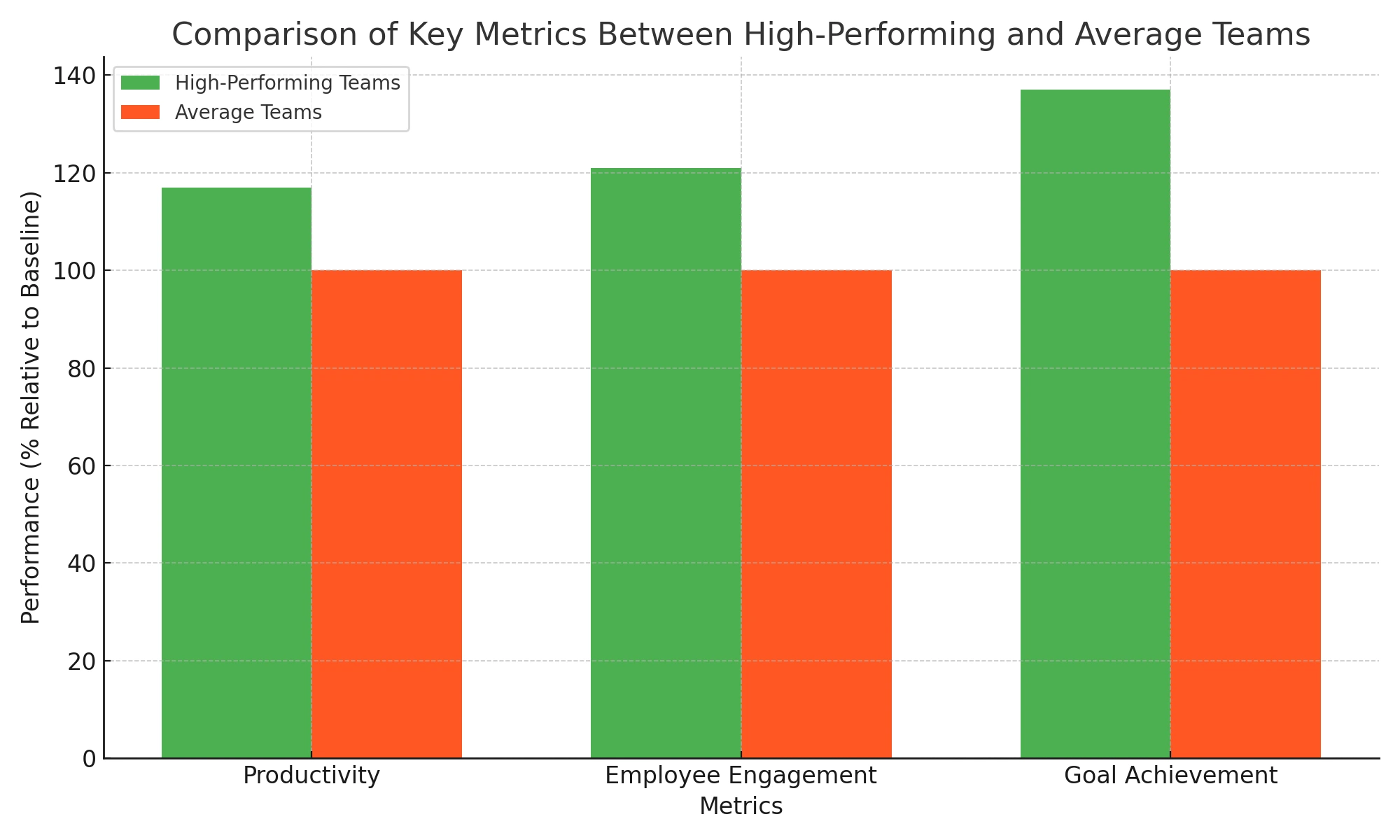
Building high-performing teams is a shared responsibility that involves leaders, team members, and organizational support. Each plays a crucial role in encouraging collaboration, driving motivation, and ensuring success.
Senior leaders set the tone for a high-performing culture. They establish the organization’s vision, values, and strategic priorities that guide team behavior.
By modeling leadership qualities such as integrity, innovation, and adaptability, senior leaders inspire teams to strive for excellence. They also ensure resources, tools, and training are available to empower teams to perform at their best.
Human Resources is pivotal in creating the foundation for high-performing teams. HR identifies and recruits talent that aligns with organizational goals and culture. They design team-building frameworks, implement performance management systems, and facilitate ongoing training and development programs. Additionally, HR plays a critical role in promoting diversity, equity, and inclusion, which are essential for team dynamics and innovation.
Managers are directly responsible for shaping and maintaining high-performing teams. They ensure clear roles and responsibilities, establish measurable goals, and provide regular feedback to team members.
Effective managers act as coaches, resolving conflicts, motivating underperformers, and maintaining team morale. They bridge the gap between strategic leadership and day-to-day team operations, thus ensuring alignment with organizational objectives.
Team members themselves play a significant role in creating a high-performing team. Employees contribute by taking ownership of their tasks, collaborating effectively, and upholding team values. Open communication, mutual respect, and a willingness to learn are critical traits of highly performing-team members.
By aligning efforts across senior leaders, HR, managers, and employees, organizations can cultivate teams that consistently deliver exceptional results.
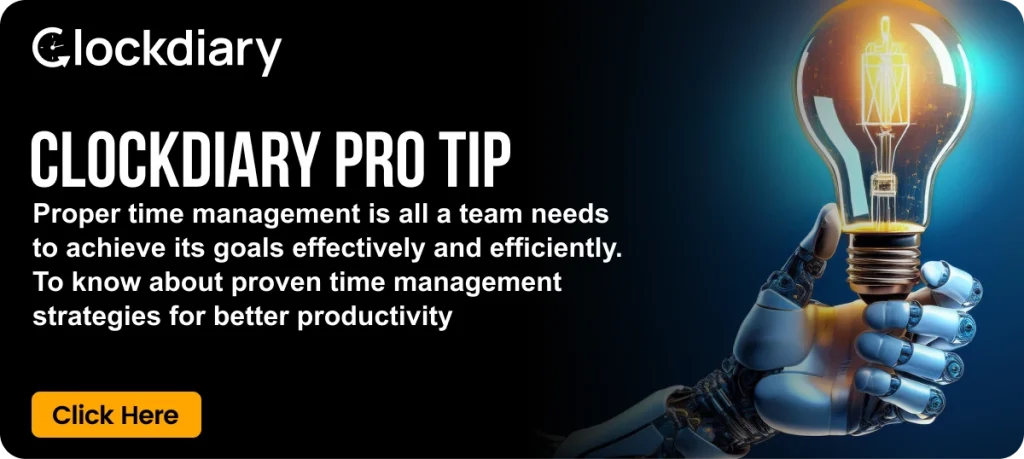
Building a high-performing team isn’t just about having talented individuals; it’s about creating an environment where collaboration, trust, and clear communication thrive. Effective strategies are essential to ensure that team members are aligned, motivated, and equipped with the right tools to succeed.
Whether you’re managing a hybrid team, navigating diverse team dynamics, or seeking ways to improve overall productivity, the right strategies can transform your team into a powerhouse. In this section, we’ll explore proven, actionable strategies to help you build and lead high-performing teams that consistently achieve exceptional results.
A clear and compelling organizational purpose serves as the foundation for building a high-performing team. However, a significant gap exists in this area. A recent survey found that 74% of employees feel they’re missing out on company news due to poor internal communication.
When team members understand why their work matters, they feel motivated and aligned with larger goals. To effectively communicate your organization’s purpose:
By fostering a shared sense of purpose, teams stay focused, inspired, and committed to achieving exceptional results.
A forward-looking mindset fuels motivation and innovation within high-performing teams. When team members are excited about future opportunities, they remain engaged and proactive. To cultivate this enthusiasm:
By fostering excitement about tomorrow, you create a culture of optimism and forward-thinking, motivating your team to work collaboratively toward a shared, inspiring future.
High-performing teams thrive when leaders set clear, ambitious expectations. When you believe in your team’s potential, they’re more likely to rise to the challenge. Show them that you trust their abilities by:
Your team will feel motivated when they know you see greatness in them. High expectations, combined with encouragement, can transform potential into extraordinary results.
The leadership style you adopt directly impacts the success of your high-performing team. Adapt your approach based on your team’s needs and organizational goals.
Effective leaders demonstrate emotional intelligence, clear communication, and adaptability. By implementing the right leadership style, you create an empowered, motivated, and goal-focused team ready to excel in any challenge.
A vision without goals is just a dream. Research indicates that setting specific and ambitious objectives leads to 90% higher performance compared to easy or vague goals. Moreover, according to a BI research study, employees who set goals are 14.2 times more likely to feel inspired at work.
To build a high-performing team, turn your vision into actionable steps by setting clear, measurable goals.
When goals are clear, your team stays aligned, motivated, and ready to achieve greatness.
A sense of urgency drives teams to stay focused and act decisively. It doesn’t mean creating constant pressure—it’s about inspiring a commitment to timely action and results. To foster urgency:
When your team understands the value of acting promptly, they stay energized and proactive, ensuring projects move forward efficiently without sacrificing quality.
A well-structured team enables smooth collaboration and efficient workflows. To align your team’s structure with organizational goals:
When your team structure supports the organization’s mission and objectives, it creates a cohesive environment where every member knows their contribution and works collectively toward shared success.
Honesty and transparency are the cornerstones of trust in high-performing teams. When leaders and team members speak openly, it brings about a culture of respect and accountability. To build trust:
When team members know they can trust each other and their leaders, it strengthens collaboration, reduces misunderstandings, and ensures everyone works towards the same goals with confidence.
A team aligned around a shared vision and clear goals is unstoppable. Regularly communicating these elements ensures everyone stays focused and motivated. To make this strategy work:
Frequent, transparent communication keeps the team united, engaged, and committed to reaching success.
Clear roles and responsibilities eliminate confusion and ensure every team member knows exactly what’s expected of them. A study by Effectory found that team members with high role clarity are 53% more efficient and 27% more effective at work, leading to a 25% increase in overall performance. Moreover, 86% of individuals with well-defined roles report high levels of effectiveness, and 83% experience increased productivity.

To create this clarity:
When everyone knows their specific role and how it contributes to the team’s success, efficiency increases, and team members feel empowered and confident in their work, thus ensuring a high-performing team.
An open mind promotes innovation, collaboration, and a culture of inclusivity. By leading with an open mind, you create an environment where diverse ideas are valued and team members feel comfortable sharing their thoughts. To implement this strategy:
When leaders maintain an open mind, teams feel empowered, leading to greater creativity and high performance.
Empowering team members through questioning rather than directing promotes ownership and initiative. When you ask insightful questions, it encourages critical thinking and problem-solving while also showing respect for their expertise. To implement this strategy:
Asking instead of telling promotes engagement, builds trust, and helps your team grow stronger and more autonomous, something which is extremely important to build a high-performing team.
Management by Walking Around (MBWA) is a strategy that helps leaders stay connected with their teams and understand the real dynamics at play. Rather than relying solely on reports or meetings, this hands-on approach allows leaders to observe firsthand how work is progressing and address issues promptly. To use MBWA effectively:
MBWA strengthens relationships, builds trust, and ensures that leaders stay grounded in reality.
In a high-performing team, fast and clear communication is essential to maintaining momentum and efficiency. Delays in communication can lead to confusion, missed opportunities, and frustration. To eliminate communication lag time:
By removing communication barriers, you streamline workflows, reduce misunderstandings, and help the team move forward with confidence.
HR plays a crucial role in building high-performing teams, and their involvement should extend beyond recruitment. A recent survey indicates that 60% of HR leaders prioritize leadership development to enhance management team effectiveness.
By actively engaging HR in team dynamics, leaders can leverage their expertise to create a supportive work environment. To make HR a key player:
Involving HR in key decisions strengthens team culture and enhances overall performance.
During a crisis, a calm and composed leader can make all the difference in guiding the team through uncertainty. Panic and stress can derail decision-making and lower morale, but a steady presence brings about confidence. To lead calmly during tough times:
By remaining calm in a crisis, you instill trust in your team, allowing them to perform under pressure and emerge stronger.
In a world full of distractions, high-performing teams excel by focusing on what truly matters. Prioritizing key objectives ensures that time and energy are spent on activities that directly contribute to success. the Eisenhower Matrix technique helps optimize your to-do list. To stay focused:
When your team concentrates on what’s important, productivity increases, and they can achieve exceptional results with greater efficiency.
Great leaders don’t shy away from acknowledging challenges, but they also provide clear paths forward. By addressing problems head-on and offering solutions, you build trust and show your team that obstacles are just opportunities for growth. To implement this strategy:
By balancing honesty with optimism, you empower your team to tackle challenges confidently and stay focused on solutions.
Building a high-performing team starts with attracting top talent. The right people elevate team dynamics, bring fresh perspectives, and drive success. To hire the best:
By hiring the best, you set the foundation for a strong, high-performing team that can achieve its goals and innovate.
Understanding the individual needs and goals of your team members is key to promoting a motivated and engaged workforce. A recent study revealed that companies with aligned goals see a 30% increase in employee performance. When employees feel their personal aspirations align with team objectives, performance flourishes.

To implement this strategy:
By knowing and supporting your employees’ needs, you ensure a stronger connection, leading to higher performance and job satisfaction.
For a high-performing team, alignment is key. When every team member’s goals align with the broader organizational objectives, it creates a unified direction and maximizes productivity. To ensure alignment:
Aligning goals ensures every team member is working toward the same mission, boosting collaboration and performance.
A healthy work-life balance is crucial for sustaining long-term performance and well-being. When team members feel supported in balancing their personal and professional lives, it leads to higher job satisfaction, productivity, and reduced burnout. To support work-life balance:
Supporting work-life balance ensures happier, more engaged employees, thereby driving both personal and organizational success.
Bringing in fresh talent and perspectives can revitalize your team and company, injecting energy, creativity, and new ideas. New blood offers innovative approaches and challenges the status quo, driving progress. To integrate new talent effectively:
New talent not only strengthens the team but also sparks growth and innovation within the organization.
In a high-performing team, outdated practices, underperforming employees, or inefficient processes can act as anchors, holding back progress. Cutting these anchors frees up resources, time, and energy, enabling the team to move forward. To implement this strategy:
By cutting anchors, you eliminate roadblocks, helping the team reach its full potential with greater agility and focus.
A proper introduction helps new hires feel welcomed, valued, and aligned with the company’s vision from day one. Research indicates that organizations with a formal onboarding process experience a 62% increase in new hire productivity. Not just that, a Click Boarding study revealed that employees who undergo comprehensive onboarding are 58% more likely to remain with the company after three years.This boosts engagement and accelerates their integration into the team.
To achieve this:
A structured introduction creates a positive first impression and helps new hires contribute effectively to the organization.
Compensating employees fairly is essential for attracting and retaining top talent. When team members feel valued financially, they are more likely to be motivated, loyal, and productive. To ensure competitive pay:
Paying a competitive wage not only boosts morale but also strengthens your team by fostering loyalty, reducing turnover, and encouraging a high-performance culture.
Transparency about financial decisions promotes trust and helps employees understand how their work impacts the organization. When employees see where the money goes, they feel more connected to the company’s mission and goals. To implement this:
By showing employees where the money goes, you build a culture of transparency, accountability, and shared purpose.
True loyalty as a leader means prioritizing the collective success of the organization over individual agendas or factions. Align your loyalty with the team that shares the company’s vision and contributes to its long-term goals. To achieve this:
Loyalty to the right team fosters trust, alignment, and a unified path to success, something hat is extremely important to build a high-performing team.
Frequent and effective meetings keep teams aligned, informed, and engaged. Regular check-ins provide opportunities to discuss progress, address challenges, and reinforce goals. To maximize the value of meetings:
Meeting regularly strengthens collaboration, builds trust, and ensures everyone is working toward shared objectives, helping your team stay high-performing and proactive.
Focusing on solutions rather than assigning blame is absolutely essential for building a high-performing team. When issues arise, redirect energy toward identifying root causes and finding ways to move forward.

To apply this strategy:
By aiming for solutions instead of blaming individuals, you build trust, inspire innovation, and create an environment where employees feel empowered to take initiative.
Letting out the “crawdads” means addressing hidden tensions, unspoken issues, or underlying conflicts within your team. These small problems, if ignored, can escalate and impact team dynamics. A recent study by McKinsey found that organizations promoting a culture of creativity and innovation see 67% higher employee engagement and are 45% more likely to be market leaders in their industries.
To implement this strategy:
By “letting out the crawdads,” you prevent issues from festering, maintain harmony, and create a healthier, more productive environment for your team.
Diversity is a cornerstone of high-performing teams, bringing fresh perspectives, innovative solutions, and stronger collaboration. When you value diversity, you create an inclusive environment where all team members feel respected and empowered. To embrace this:
By valuing diversity, you unlock your team’s full potential, enhancing problem-solving, innovation, and overall performance while promoting a culture of equity and respect as well.
A sense of humor can transform workplace dynamics, making teams more cohesive and resilient. Laughter reduces stress, boosts morale, and encourages stronger relationships among team members. To encourage humor:
When leaders and team members embrace humor, they create a positive, energized atmosphere that promotes creativity, collaboration, and a stronger sense of connection within the team.
Active listening is one of the most powerful tools for building trust and understanding within a team. When leaders take the time to genuinely hear their team members, they uncover valuable insights and foster a culture of respect, something which is a must to build a high performing team. To apply this strategy:
By truly listening, you empower your team, improve communication, and create an environment where everyone feels valued.
Stepping back to view the “big picture” allows leaders to assess team dynamics and performance objectively. By getting a higher-level perspective, you can identify strengths, challenges, and patterns that may not be visible in the day-to-day grind.
From the “balcony,” leaders can align the team’s efforts with broader goals, ensuring sustainable growth and success.
Respecting your team’s time demonstrates professionalism and promotes trust. A study from the University of Oxford found that happy workers are 13% more productive. Moreover, only 37% of U.S. employees feel they are treated with respect at work, according to a recent Gallup study.
Efficient time management ensures productivity while supporting work-life balance as well. To honor people’s time:
When you value your team’s time, you show respect for their efforts, enhance morale, and create a culture where productivity and well-being thrive together.
Inspired by the famous FISH! Philosophy, this strategy emphasizes creating a fun, engaging workplace where people enjoy their work. After all, if people enjoy their work, it will lead to the formation of a high-performing team. Teams that have fun together are more motivated, creative, and connected. To embrace this:
A playful yet purposeful environment keeps teams energized, improving morale and boosting overall performance.
Engaging in community initiatives strengthens team bonds while showcasing your organization’s values. Participating in meaningful activities inspires pride, purpose, and a sense of shared accomplishment. To make an impact:
By giving back, your team not only helps others but also grows stronger together, creating a culture of empathy, collaboration, and commitment that extends beyond the workplace.
A high-performing team thrives on continuous growth, which often requires stepping outside comfort zones. Great leaders challenge their teams to aim higher, embrace innovation, and adapt to change. This discomfort sparks creativity and drives performance.
By keeping the team slightly uncomfortable, leaders inspire innovation, resilience, and a hunger for success, ensuring the team remains high-performing and ready to tackle evolving challenges.

To build a high-performing team, fostering a culture of innovation is essential. A 2024 report by Boston Consulting Group found that while 83% of companies rank innovation as a top-three priority, only 3% are prepared to effectively implement it.
Staying ahead of competitors requires creative thinking, agility, and the courage to challenge the status quo. Encourage your team to:
When teams innovate, they unlock their potential, boost productivity, and position the organization as an industry leader, ensuring sustained success in a competitive landscape.
High-performing teams mirror the behaviors of their leaders, making personal growth an essential component of leadership. To inspire your team, lead by example:
When leaders prioritize their growth, they create a culture of development and inspire their teams to follow suit. Change starts at the top, fueling transformation across the organization.
As a leader, being the embodiment of change sets the tone for your team’s success. When you model adaptability and a positive attitude toward change, your team is more likely to follow suit. To lead change effectively:
By being a role model for change, you inspire your team to embrace transformation and drive progress.
Empowering employees to contribute their ideas brings forth a culture of innovation and collaboration within a high-performing team. When team members feel heard and valued, they are more motivated to share solutions that benefit the organization. To encourage contributions:
By rewarding ideas, you inspire a proactive, engaged team committed to continuous improvement and success.
To shape the behavior of a high-performing team, you must align rewards with the desired outcomes. If you consistently reward certain actions or results, you reinforce those behaviors. To drive positive change:
By changing what you reward, you foster the behaviors that drive long-term performance and growth.
While moving forward is crucial for a high-performing team, honoring and cherishing the past can provide valuable lessons and a sense of continuity. A study by Quantum Workplace found that when employees feel valued, they’re more engaged and motivated to contribute to the company’s success.
Recognizing past achievements and learning from previous challenges creates a strong foundation for future success. To honor the past:
By cherishing the past, you build a strong, cohesive team culture that values both growth and history.
Recognition should never feel like a task—it should be a natural part of your leadership style. A high-performing team thrives on consistent, genuine acknowledgment of their efforts and achievements. Instead of treating recognition as a box to check:
By integrating recognition into your leadership, you create a motivated, engaged team that feels truly valued.
Balancing planned and spontaneous recognition promotes a culture of appreciation within high-performing teams. Planned recognition, such as awards or annual celebrations, creates consistent opportunities to celebrate achievements. Meanwhile, spontaneous recognition feels authentic and reinforces positive behavior in the moment.
This combination keeps team members motivated, valued, and engaged, driving productivity and fostering a positive, performance-driven workplace culture.
Top performers are the backbone of any high-performing team, and recognizing their efforts with meaningful rewards ensures they feel valued and motivated. Customize rewards to reflect the magnitude of their contributions and align them with their preferences.
By appropriately rewarding high achievers, you foster loyalty, encourage excellence, and set a standard of appreciation that inspires the entire team to strive for greatness.
Celebrations, no matter how small, can significantly boost morale and build camaraderie within a high-performing team. Recognize milestones, whether it’s completing a challenging project, achieving quarterly goals, or welcoming a new team member.
Frequent celebrations promote a sense of accomplishment and belonging, keeping your team motivated, engaged, and ready to tackle the next challenge together. Make joy part of your workplace culture.
Acknowledging special days—both personal and professional—strengthens bonds within a high-performing team. Celebrate birthdays, work anniversaries, and personal milestones to show employees they’re valued beyond their contributions at work.

Taking time to honor these occasions fosters a sense of belonging, boosts morale, and creates a positive team culture. Small gestures on special days make a lasting impact, reinforcing loyalty and engagement.
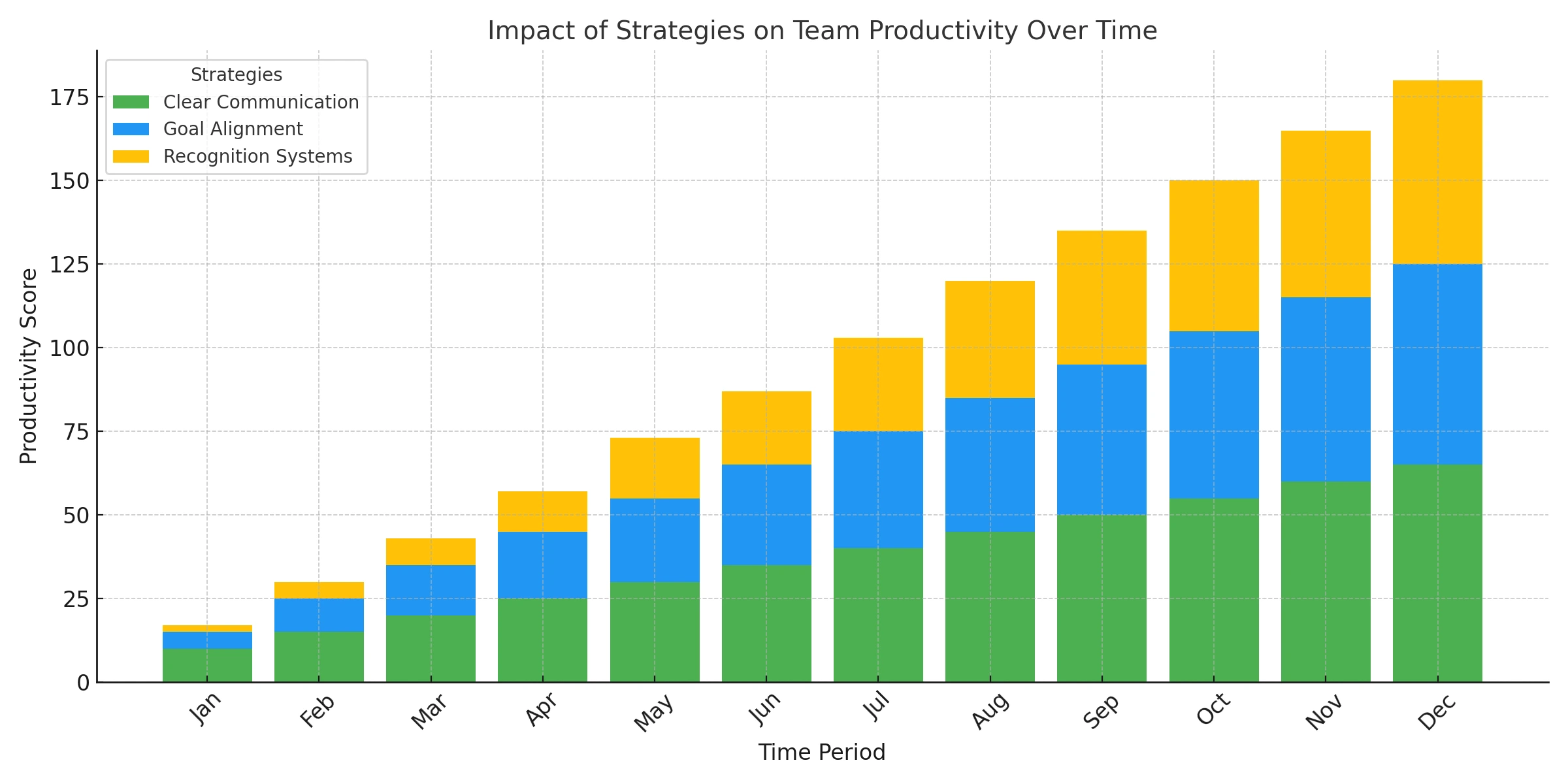
In today’s fast-paced business environment, performance management software has become absolutely essential for building high-performing teams. These tools streamline tracking, evaluating, and enhancing team productivity, ensuring every member aligns with organizational goals. Among the many options available, Clockdiary stands out as an excellent performance management software.
Clockdiary simplifies time tracking, allowing managers to monitor individual and team efforts effectively. This feature ensures accountability and provides valuable insights into how time is allocated, helping identify areas for improvement. The app also enables goal setting and progress tracking, ensuring team members stay aligned with department and organizational objectives.
Key Features of Clockdiary That Support High Performing Teams Include:
Understanding where time is spent is crucial for team optimization. Clockdiary’s advanced time-tracking tools allow team members to log their work hours seamlessly, ensuring accountability and helping leaders identify inefficiencies. This fosters better task prioritization and workload distribution.
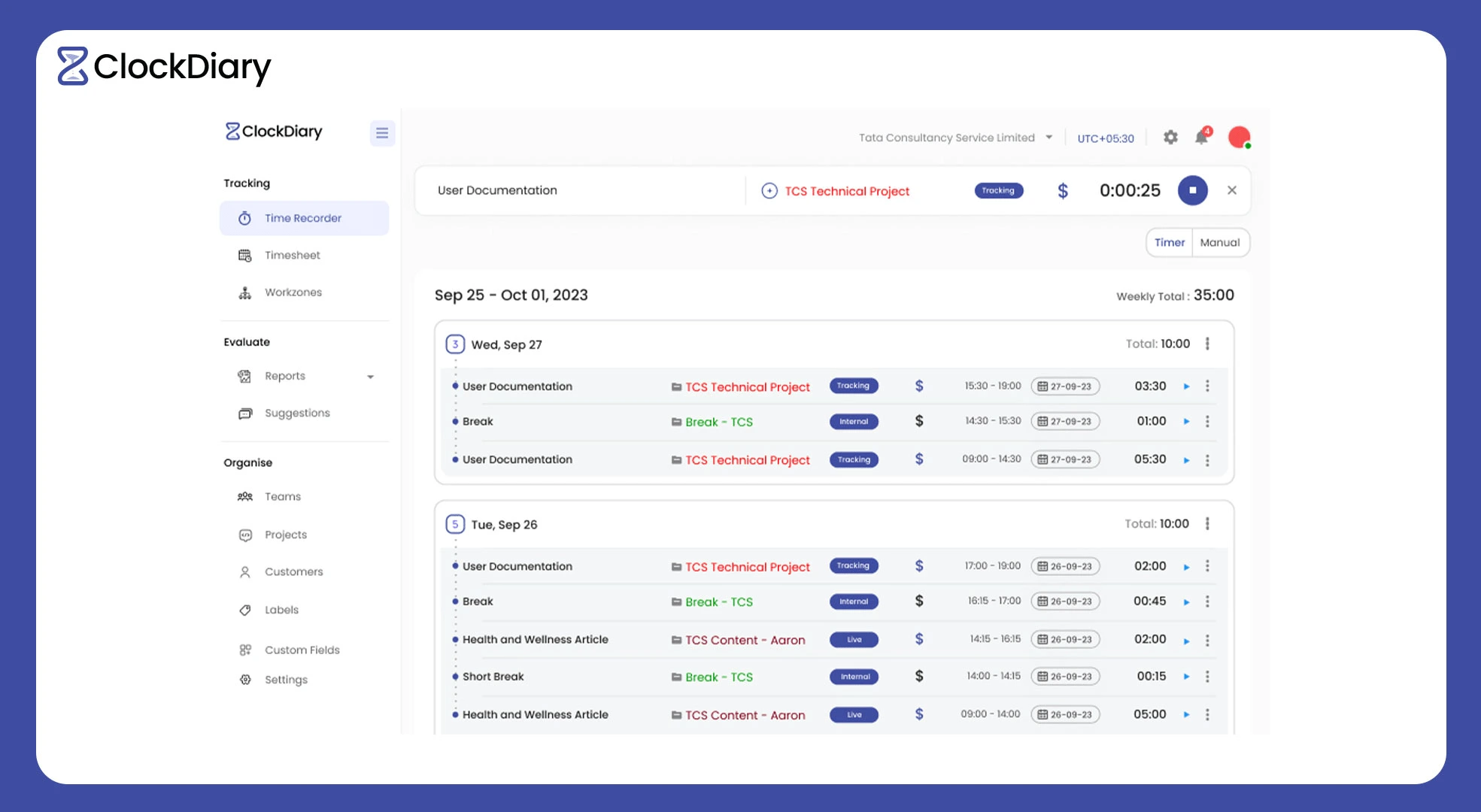
High-performing teams thrive on clear goals. Clockdiary allows managers to set, align, and track individual and team objectives. This ensures everyone is working towards a common purpose, improving motivation and driving organizational success.
Clockdiary’s AI-powered screen monitoring captures screenshots at regular intervals to provide insights into employee productivity patterns. This helps leaders identify distractions or roadblocks while maintaining transparency and trust within the team.
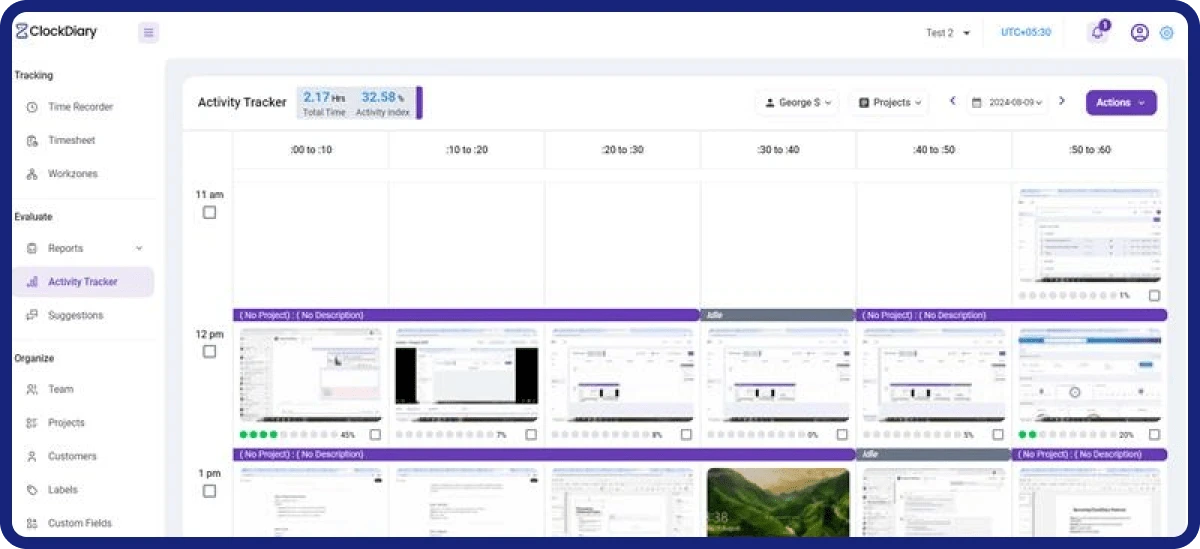
Detailed reports provide a bird’s-eye view of team performance, progress toward goals, and project timelines. Clockdiary’s reporting features enable data-driven decisions, helping leaders focus on areas requiring improvement while celebrating achievements.
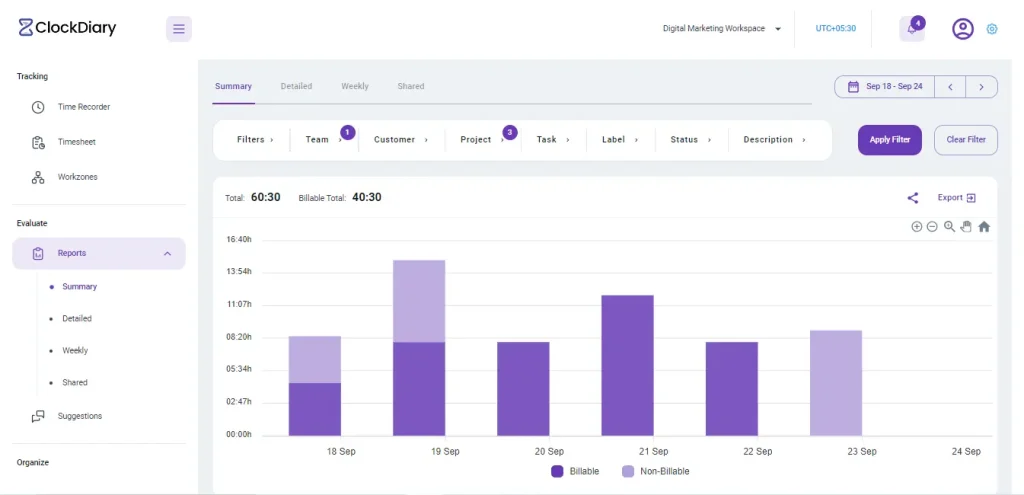
The built-in AI assistant simplifies task management and helps employees stay organized by offering reminders, suggesting efficient workflows, and prioritizing tasks. This fosters a culture of efficiency and proactive work habits.
By integrating tools like Clockdiary, managers can foster transparency, improve communication, and ensure alignment with organizational goals. The result? A cohesive, motivated, and high-performing team that thrives on accountability and collaboration. Thus, it goes without saying that investing in the right performance management software is a step toward long-term success and sustained team excellence.
Building a high-performing team is not an overnight process—it’s a journey of strategic planning, clear communication, and consistent effort. By implementing proven strategies, leveraging tools like performance management software, and fostering a culture of collaboration and accountability, you can create a team that consistently exceeds expectations.
Remember, the foundation of a high-performing team lies in aligning individual goals with organizational objectives while prioritizing employee well-being as well. Start today by taking small, actionable steps toward building a motivated, engaged, and results-driven team. The sooner you begin, the closer you’ll be to achieving sustainable success and driving exceptional results.
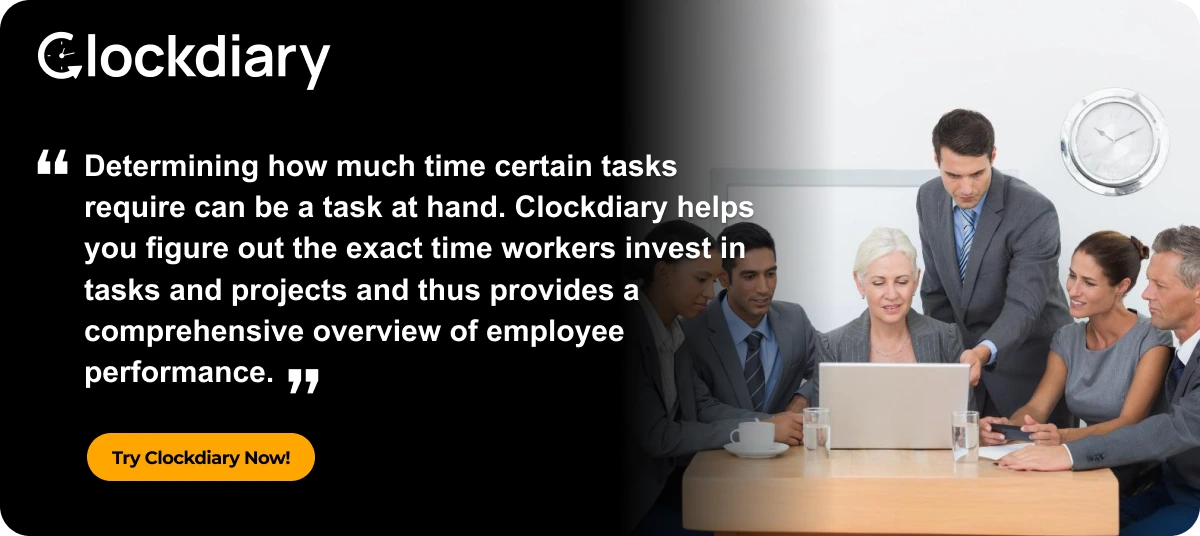
FAQs:
The five key behaviors of a high-performing team include trust, constructive conflict, commitment, accountability, and a results-driven focus. These behaviors encourage open communication, align team efforts toward shared goals, and create an environment where every member is motivated to contribute their best.
The five keys to a successful team are clear goals, open communication, mutual trust, effective leadership, and a collaborative culture. These elements ensure alignment, foster accountability, and empower team members to work cohesively toward achieving shared objectives.
Building a high-performing team involves setting a clear vision, defining roles, and ensuring open communication to ensure alignment and trust among members. By leveraging strategies like goal setting, providing consistent feedback, and recognizing achievements, leaders can inspire collaboration and drive exceptional results.